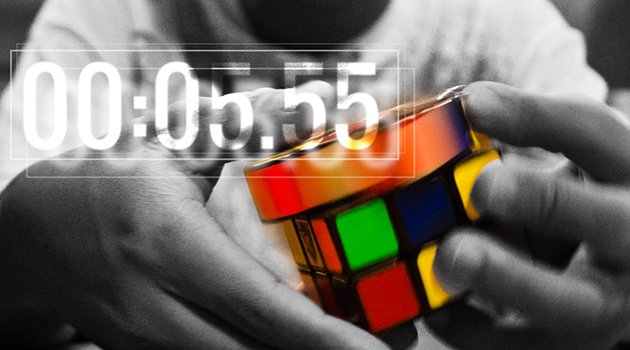SPEED CUBING
After the invention of the Rubik’s Cube in 1974 by a Hungarian professor named Erno Rubik, the Cube took off and gained a worldwide following. The first Rubik’s Cube World Championship was held in 1982 in Budapest, Hungary. The winner was Minh Thai (USA) with a relatively slow (compared to modern times) solve of 22.95 seconds. Cubes used in the early days of speed cubing where standard Rubik’s Cubes with simple modifications. This first competition was also attended by other cubers; some who would eventually become giants in the cubing world such as Lars Petrus (Sweden) and Jessica Fridrich (Czech Republic). Speed cubing World Championships then lay dormant until they were once again reawakened in Toronto, 2003. By this time solving techniques such as the Friedrich method and the Petrus system where already well advanced, allowing solve times to have decreased to sub 17 seconds, however the cubes where still crude. Dan Knights won the 2003 World Championship with a time of 16.71 seconds, which was at that time a world record. Since 2003 a World Championship has been held every two years, with Nationals and Regionals held in between. Although competitions now include far more puzzles and events, the 3x3 is still the most popular. Speed Cubes and algorithms have advanced so that times below 6 seconds are now achievable. The Rubik’s Speed Cube is the result of over 30 years of innovation within speed cubing and is the most advanced and fastest Rubik’s Cube to date.
Rubik’s Speed Cube
We have developed the fastest Rubik’s Cube yet! The traditional stickers have been replaced with plastic; which means no fading, peeling or chipping! The Rubik’s Speed Cube has an all new mechanism with faster movement, amazing corner cutting and zero pops. Basing it around a brand new spherical enclosed core design ensures that there is minimal friction between internal moving parts, but also between cubies. This revolutionary new design allows not only for faster turning parts but also balances fantastic corner cutting with no pop technology. Never again will you pop doing a record time. Buy a Rubik’s Speed Cube
Fridrich Method
This is the most popular of Speed solving methods. Its origins lie not with Jessica Friedrich however, but with other cubers. David Singmaster was one of the first people to publish a layer by layer method for solving the cube. This was then evolved by Guus Razoux Schultz, who developed a basic F2L (First two Layers). This is where the first two layers of the cube are solved simultaneously rather than individually, cutting the solve time down considerably. In steps Jessica Friedrich to the story. Jessica was able to polish this method by adding the final two elements: OLL (Orientation of the Last Layer) and PLL (Permutation of the Last Layer). The progression of this method is therefore: The Cross, F2L, OLL and PLL. We have created a Beginners Guide to the Fridrich Method to help you get faster at solving the Rubik’s Cube. There is also a video to accompany the OLL and PLL steps. Other Methods for speed solving also exist such as the Petrus System or the Gilles Roux Method, however these are not as widely used as the Friedrich Method.
Lubrication
In order to have a fast speed cube, lubricating your cube is essential. It is a good idea to learn a method for speed solving or at least play with your cube before applying lube, as this will help “break in” your cube. Once your cube is “broken in” you will need to lube it thoroughly.
Rubik’s Lube
We recommend using the Official Rubik’s Lube, not just because it’s Rubik’s, but because we have searched high and low for the perfect formulation for lubricating the Rubik’s Speed Cube. Rubik’s Lube will allow you to maximise the cubes potential and achieve record beating times. This lubricant is part of the silicone family, so it won’t rot the plastic in the cube like some lubricants. Much like crude oil, from which Bitumen (the sticky tar that roads are made of) and Petroleum (that we put in our automobiles), silicone comes in many forms. Just as you wouldn’t want to make a road of gas or put tar in your gas tank, don’t put other lubricants in your cube. Rubik’s Lube is the perfect viscosity to balance speed and longevity. Our Rubik’s Lube is so pure that it is actually food safe, but we wouldn’t recommend eating it!
Tensioning
Tensioning is where you change the force of the springs so that the cube is looser or tighter. This is a very personal thing and you will need to play with the tensions on your cube until you get the one you feel most comfortable with. When you first get your Rubik’s Speed Cube it will be set up to our preference, which may not be yours. Luckily it is extremely easy to tension the Rubik’s Speed Cube. Underneath each of the middle tiles (which can be removed with a slotted screwdriver) is a screw head. To tighten the tension on your cube screw it clockwise and to loosen turn it anticlockwise. You will need to do this to all 6 centre tiles equally until you have the desired tension. For more advanced cubers, or if you cannot get the exact tension you want, we have included two sets of extra springs, one tighter and one looser than the ones the Rubik’s Speed Cube is supplied with. Here is a guide onHow to Customize the Rubik’s Speed Cube Here are some videos on How to make the Rubik’s Speed Cube faster
Finger Tricks
Once you have learned a method that suits you, you will need to get faster. This can be done with the aid of finger tricks. Finger tricks are essentially a way of rotating the layers on your cube quickly without taking the time to re-grip the cube. An example of a basic finger trick to turn the top layer would be to hold the cube with the thumb and ring or middle finger and rotate the layer with your forefinger. Different layers require different movements but the basic premise is that the layers can be flicked around with one finger, meaning you will be able to cut down your time. Here is Alexander Lau’s Introduction to Rubik’s Cube Fingertricks Alexander Lau is ranked 3rd in the world for solving the Rubik’s Cube. His official WCA time is 5.96 seconds to solve the 3x3 Rubik’s Cube. This is his beginners guide to finger tricks - one of the things that makes him such a successful Speed Cuber. Full set of Official WCA Rules and Regulations can be found at:www.worldcubeassociation.org/regulations
Source: https://www.rubiks.com/speed-cubing
Not citing sources of copied works is plagiarism and frowned upon by the community.
Sharing content and add value by:
Repeated plagiarized posts are considered spam. Spam is discouraged by the community, and may result in action from the cheetah bot.
Creative Commons: If you are posting content under a Creative Commons license, please attribute and link according to the specific license. If you are posting content under CC0 or Public Domain please consider noting that at the end of your post.
Not indicating that the content you copy/paste is not your original works could be seen as plagiarism.
If you are actually the original author, please do reply to let us know!
Thank You! ☙
Why would you ever promote any Rubik's brand product?